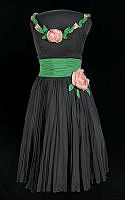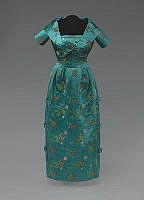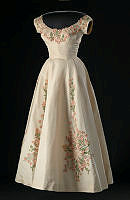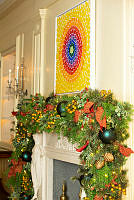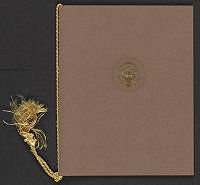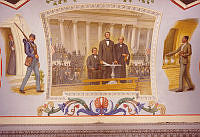Rubenstein Center Scholarship
Slavery's Mark on Lincoln's White House
This article is part of the Slavery in the President’s Neighborhood initiative. Explore the Timeline
On a bright March 4, 1861, Abraham Lincoln took office as President of the United States “entirely ignorant not only of the duties, but of the manner of doing the business,” and so he soon confessed.1 Happily for him and Mrs. Lincoln, the domestic staff had much to teach them both. All of the servants were free men and women, but many had been enslaved or descended from enslaved families, including the able staff who guided Mrs. Lincoln through the management of the house, influenced her husband’s thought, and vetted his timeless rhetoric.
Some of the veteran servants were European born.2 Appointed by President Franklin Pierce, the Prussian Louis Burgdorf kept Lincoln’s office door in a style “little tolerant of interference.” At the other end of the personality scale, the miniature Irish porter, “Old Edward” McManus, had charmed a succession of presidents with an “inexhaustible well of incident and anecdote concerning the old worthies and unworthies.”3 Other White House servants were British or Belgian immigrants.4 But in 1942, an African-American dentist and amateur historian named John E. Washington wrote a groundbreaking book about the accomplished men and women of African descent who had led their community in Lincoln’s day and anchored his domestic staff.5 Having known some of them in his youth and interviewed their children, Dr. Washington believed, with ample good cause, that Lincoln saw in them “an example of what freedom would accomplish.”6 More than that, they may have eased his fear that slavery’s bitter legacy would keep blacks and whites from living together in postwar harmony.

Abraham Lincoln's First Inauguration, March 4, 1861.
Library of CongressLincoln made it clear that “I take no charge of the servants about the house,” but a frequent guest observed that he gave them “peculiar care and solicitude” and let them bear no hardship he could lift.7 Years later, one of the African-American staff said he treated them “like people,” as if it were exceptional, which it was for that time and place. Dr. Washington’s sources recalled how Lincoln would “laugh and say kind things” and always request their service “rather than demand it of them.” He “sympathized with us colored folks,” one former servant said, “and we loved him."8
Mrs. Lincoln, nonetheless, was the “absolute mistress” of the White House, Lincoln’s aide William Stoddard wrote, except for the office wing upstairs.9 Unfortunately, her credentials, unimproved by an explosive temperament, fell short of the job. She had grown up in Kentucky commanding enslaved servants in her father’s household but had no idea how to run the Executive Mansion. Many of the “colored” staff, Dr. Washington wrote, “knew better than she what was to be done, how it should be done, and why it should be done.”10 Some of them helped her through it, but others left to “live with gentlefolks,” and the staff turned over with record speed.11 Dr. Washington’s sources recalled Mrs. Lincoln fondly and insisted that “her bark was worse than her bite,” but the record shows time and again that her bite was as fierce as her bark.12
Predictably enough, the basement was the servants’ domain. Built into ground that sloped north to south down from Pennsylvania Avenue, the basement was almost subterranean in the front of the house and a walkout in the back. An eclectic collection of workrooms, storage rooms, and bedrooms comprised its servants’ hall, a gloomy old place reminiscent of the medieval, but for the ranking servants’ rooms overlooking the Potomac. The vast whitewashed kitchen on the north side of the basement had sand on its brick-paved floors to absorb grease and water, and a faint northern light ineffective against mildew.13 To venture into the basement, Stoddard wrote, was to be “reminded of old country taverns, if not of something you have smelled in the edge of some swamp.”14

A View of the Lincoln White House, ca. 1860s.
White House Collection/WHHAYet the staff had their privileges. A White House note to the right official helped an African-American servant named Thomas Cross get his nephew a coveted pass to Savannah through the Union lines.15 Some of Lincoln’s domestic staff had a chance to travel with him and housed their families at the White House. On a train to occupied Virginia, where Lincoln would stay on the presidential steamboat River Queen, a French marquis found him “blind to race or color” as he seated its “negro waiters” in his private car “with us.”16 According to Dr. Washington the White House cook, Cornelia Mitchell, “well educated for a colored girl of her day,” had a range that ran from fine cuisine to the president’s favorite corn pone and cabbage. Her children lived with her in the servants’ hall, “and her oldest daughter was allowed to receive her company there."17
Whenever the spirit moved them, the Lincoln boys, Willie and his younger brother Tad (the irreverent house comedian) would draft the servants’ children for their fort on the White House roof or for baseball on the south lawn.18 “There was no color line there,” a black servant’s son recalled, and the “bootblacks and other colored boys who came and peeped through the fence were invited in.”19 A visiting English girl watched a boy on the White House stairs “doing his best to upset the gravity of the servants” until Mrs. Lincoln spoke to him. “I think they called him Thad.”20
Not all of the African Americans in Lincoln’s White House were servants. The once enslaved Rosetta Wells and her friend Mrs. John Brooks were seamstresses paid by the day.21 Elizabeth Keckly, Mrs. Lincoln’s dressmaker, had been born into slavery in Virginia. Whipped from the age of four, abused in every way, then sold to a liberal owner, she purchased freedom for herself and her son by sewing dresses for paying customers. By 1861, she was a fashionable “modiste” and an almost daily presence in the White House, where she fitted Mrs. Lincoln’s clothes, dressed her for formal events, and became her confidante —“Lizabeth” to the first lady, “Madame Elizabeth” to the president. A “magnificent-looking woman,” Dr. Washington wrote, and a graceful conversationalist with a musical voice, Mrs. Keckly “considered it inelegant to cross the street except at the intersection.” Wherever she went, “people would turn to admire her carriage.” Lincoln would sometimes ask her to make him presentable and “sit quietly while I arranged his hair,” her memoir says. “I loved him for his kind manner towards me,” she wrote, for he treated her like “the white people about the house.”22

Elizabeth Keckly, Mrs. Lincoln's dressmaker.
Moorland-Spingarn Research Center, Howard UniversityPeter Brown, a White House waiter and dining room manager freed from slavery, was one of Lincoln’s favorites. His young son Robert helped in the kitchen, ran errands, and played with the Lincoln boys. The president got to know him but mistakenly called him Peter, like his father. Many years later, Robert Brown told Dr. Washington how Lincoln called out to him in the hall.
“Peter, are you hungry?”
“Always, Mr. President.”
“Well, that’s a terrible state for a growing boy to be in. We’ll have to see about that!” Then he called to the boy’s father. “Peter, I want you to feed this boy. He looks hungry and admits it. Fill up his legs too. If he’s like my boys, his legs are hollow.”23
A gifted singer named Mary Dines cooked for the Lincolns at the Soldiers’ Home, their summer residence in rustic northwest Washington. At the White House, she helped nurse their boys through typhoid fever, which Tad survived and Willie did not. Tracked by a vicious owner’s hounds, Mary Dines had escaped from slavery in Maryland, hidden in a hay wagon. Taught to read and write by a former owner’s children, “Aunt Mary” wrote letters for fugitive slaves at the contraband camp on Seventh Street and led them in “Negro spirituals” when the president came to visit. Lincoln joined in, and left with tears in his eyes. 24

Mary Dines's choir at the 7th Street contraband camp.
National Archives and Records AdministrationNear the top of the servants’ scale stood William Slade, ”a faithful man” wrote one of Lincoln’s secretaries, “prudent and dignified.”25 Like Cornelia Mitchell, he was said to be proud of his “distinguished Southern ancestry."26 A Virginian with olive skin, light eyes, chestnut-brown hair and a goatee, variously called a butler, messenger, valet, and “mulatto doorkeeper,” he did all of those jobs and more, but his title was White House Usher, one of the highest posts available to a black Washingtonian. To Lincoln he became an intimate friend.27 He and his wife Josephine, the daughter of a woman who had been enslaved at Mount Vernon, lived with their children in a boarding house they owned and operated at 464 Massachusetts Avenue, where Tad played with “real boys and girls, white and colored.”28 Slade kept a set of White House keys, had a room in the servants’ hall, “and knew every diplomat, general, and statesman” in town.
Ranking second only to the White House steward, who managed the household’s accounts and oversaw its operations, Slade arranged formal functions, served at dinner parties, prepared special dishes, and “bossed all the help,” in the words of Rosetta Wells.29 Elderly veterans of Slade’s regime told Dr. Washington that when large-scale White House events exceeded their capacity, cooks and waiters were recruited “from among the colored men who worked for other officials and knew just how to handle things” under the joint command of Cornelia Mitchell and William Slade.
Beyond his many White House duties, Slade was the president of the Social, Civil, and Statistical Association, which collected information on black schools, businesses, and properties to show that formerly enslaved people thrived in freedom. He was also the head of an association of African-American churches and civic groups; a leader of a mutual aid association; an elder at the prestigious 15th Street Presbyterian Church, where most of the black White House servants worshipped; and a friend of Frederick Douglass. A raconteur with “a wonderful disposition,” Slade spent hours lifting the president’s burdens off his shoulders. “Lincoln just had to have somebody to loosen up on,” another servant said. Near the end of the war, under pressure to hang Jefferson Davis whenever he was captured, the president confessed to Slade. “This talk about Mr. Davis tires me,” he said. “I hope he will mount a fleet horse, reach the shores of the Gulf of Mexico, and drive so far into its waters that we shall never see him again.”30
Slade’s contributions to Lincoln’s presidency were not confined to a friendly ear. When a committee of African-American leaders wrote to Secretary of War Edwin Stanton asking to help choose officers for the city’s black regiments, the first signature belonged to William Slade, who added a private note to the President of the United States. Lincoln’s usher sometimes knew what the president was planning even before his senior aides John Nicolay and John Hay did. As he tried to move all Americans, black and white, formally educated or not, Lincoln would test important speeches on Slade. “William, how does that sound?” Only then would he try them on Nicolay and Hay. Slade knew every word of the Emancipation Proclamation before it was published, and he may have influenced a few.31
Some of the servants were offered bribes for information and insisted years later that none of them succumbed, but their share of moral failings matched the stock of other mortals.32 On Lincoln’s trip from Illinois to his first inauguration, the New York Herald reported from the train that William H. Johnson, his African-American bodyguard, messenger, handyman, barber, and valet, “although not exactly the most prominent, is yet the most useful member of the presidential party.”33 Lincoln trusted him implicitly, but only days into the new administration, Johnson’s peers cast him out for the color of his skin.34

William Slade, White House usher for President Abraham Lincoln and later steward for President Andrew Johnson.
Abraham Lincoln Presidential Library and MuseumDr. Washington wrote that White House servants, “jealous and fearful of their jobs when a new President took office,” were not famous for welcoming newcomers, and surely not this one. “Johnson’s color was very dark, and White House servants were always light.” They shunned him and made his life miserable.35 Not yet prepared in 1861 to upset racial norms even within his household, Lincoln asked Secretary of the Navy Gideon Welles if he had a job for Johnson, and plainly told him why: “The difference of color between him and the other servants is the cause of our separation.”36 Welles had no job to give but, at Lincoln’s request, his Secretary of the Treasury Salmon Chase made Johnson a Treasury Department laborer, soon promoted to serve as a messenger. Lincoln paid him even then to come to the White House in the mornings to tend his clothes and shave him, “as his family are poor.”37 He could only borrow money for a house when Lincoln guaranteed the mortgage.38
Brought along as a valet on the president’s trip to Gettysburg in November of 1863, Johnson may have heard and remarked on the Gettysburg address as Lincoln polished it on the train.39 The president felt an illness coming on at the ceremony, which worsened on the way home, as Johnson hovered over him and made him as comfortable as he could. Diagnosed in Washington with a milder form of smallpox, Lincoln could barely move. Johnson too came down with the disease, spread by contact with an infected person, most commonly during the onset of symptoms.40
On January 12, 1864, the Chicago Tribune’s man in Washington found the president in his office, recovered from his illness and counting greenbacks one by one. It “is out of my usual line,” Lincoln said, “but a President of the United States has a multiplicity of duties not specified in the Constitution or acts of Congress.” William Johnson was not strong enough to draw his pay, the president said, being “very bad with the smallpox,” and Lincoln was dividing it as Johnson wished, putting part of it in a sealed envelope, which he signed and labeled “very carefully.” He had not infected his loyal friend, he told the reporter; “at least I think not.”41
In a day or two, Johnson was dead. Lincoln paid for his burial, sent money to his family, retired his mortgage, and paid off half of another loan he had cosigned for him. He had tried to pay it all, but the banker insisted on canceling half the debt. “After this,” the banker told Lincoln, “you can never deny that you endorse the Negro.” Lincoln replied with a laugh. “That’s a fact,” he said, “but I don’t intend to deny it.”42

Watch Meeting-December 31st, 1862-Waiting for the Hour. This painting by William T. Carlton captures the moments before the Emancipation Proclamation took effect at midnight on Thursday, January 1, 1863.
White House Collection/White House Historical AssociationAfter William Johnson had left the White House for the Treasury Department, a young black man named Solomon Johnson (no relation) had been hired to cut Lincoln’s hair and trim his beard. In the wake of William’s death, Lincoln asked Secretary Chase to give the vacant job to Solomon. In 1867, still at the Treasury Department two years after Lincoln’s assassination, Solomon Johnson became the federal government’s first African-American clerk. Seeking promotion in 1881, he wrote to President Garfield’s Secretary of the Treasury William Windom as “a colored man and a voter.” He had started as a messenger, he wrote, “upon the request of the lamented Abraham Lincoln,” studied law at Howard University, and “endeavored to improve myself in such liberal culture as becomes a good citizen.” Four years later, Solomon Johnson died as a First Class Clerk.43
Andrew Johnson, Lincoln’s successor, kept William Slade in his post as White House Usher then promoted him to steward. Slade was almost surely the first African American to serve as White House steward. Having invested in Washington real estate, Slade left his family over $100,000 when he died, nearly as much as Lincoln had left his, the equivalent of several million dollars today.44 Click here to learn more about the enslaved households of President Andrew Johnson.
Lincoln had known and respected African Americans in Illinois, but he learned a great deal from the diverse points of view and inspiring life stories he encountered at the White House.45 The remarkable men and women of African ancestry who worked and lived alongside him there, accomplished figures like William Slade, Elizabeth Keckley, Solomon Johnson, and Mary Dines, showed him something new and helped him through his struggles. Beyond their contributions to the comforts of his home, the formerly enslaved and their descendants who distinguished his domestic staff surely influenced his thoughts about race, the ability of slavery’s victims to rise above it, and the prospect of achieving equality in a multiracial society.
James B. Conroy is the author of three books on American history, including Lincoln’s White House: The People’s House in Wartime (Rowman & Littlefield, 2017), and Jefferson’s White House: Monticello on the Potomac (Rowman & Littlefield, 2019). His website, www.jamesbconroy.com, includes synopses, excerpts, and reviews.


